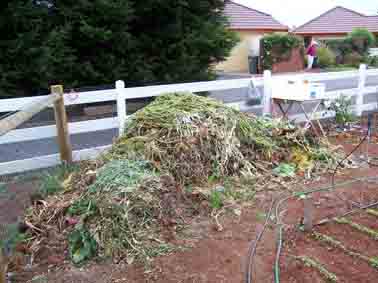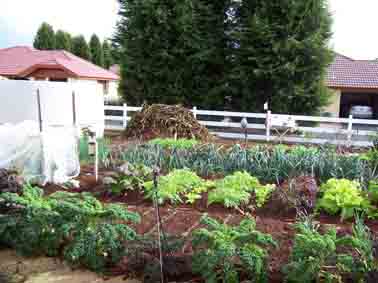
Perfect compost
 Despite relying on complete
organic fertilizer
as his primary source of soil nutrients, Steve Solomon is clearly an
expert compost-maker. For those of us who use a slapdash approach
to composting, Solomon's composting description in Gardening
When It Counts is a
must-read. He explains that a good compost has more than 1.5%
nitrogen, a C:N ratio no higher than
15:1, and lots of micronutrients.
Despite relying on complete
organic fertilizer
as his primary source of soil nutrients, Steve Solomon is clearly an
expert compost-maker. For those of us who use a slapdash approach
to composting, Solomon's composting description in Gardening
When It Counts is a
must-read. He explains that a good compost has more than 1.5%
nitrogen, a C:N ratio no higher than
15:1, and lots of micronutrients.
The
carbon to nitrogen ratio, often shortened to "C:N" or "C/N" is at the
heart of building a perfect compost heap. The availability of
nitrogen in the compost is largely determined by this ratio, which can
be thought of as a bit like the pH scale. A C:N ratio of 12:1
(twelve parts carbon to one part nitrogen) is "neutral" --- this is the
C:N ratio of soil humus and is relatively stable. Most plant
matter has a C:N ratio higher than 12:1, which means that decomposing
microorganisms require a net input of nitrogen while they're
breaking down the first of the carbon --- this is why putting fresh
wood chips on your garden does more harm than good, locking up the soil
nitrogen for the first few years before the chips break down (and their
C:N ratio drops low enough) so that they begin releasing
nitrogen. On the other end of the spectrum, chicken manure has a
C:N ratio of about 6:1, which means that the manure provides nitrogen to the soil, and
actually breaks down soil humus in the process. The table below
lists the C:N ratios of various compostables. For immediate use
on your garden, you can mix and match until the C:N ratio of your pile
is around 15:1.
| 6:1 or lower |
12:1 |
25:1 |
50:1 |
more than
100:1 |
| Meat scraps Chicken manure Hair/feathers Urine (0.8:1) |
Vegetables Garden weeds Horse manure (no bedding) Cow manure (no bedding) Spring grass Garden soil Comfrey leaves Coffee grounds |
Summer grass Legume hulls Fruit waste Grass hay (green) |
Cornstalks (dry) Straw (cereal) Grass hay (poor) Corrugated cardboard Tree leaves (deciduous) Autumn grass |
Sawdust (500:1) Paper (175:1) Tree bark Pine needles |
 Luckily for those of us with large masses
of high C:N waste, a compost
pile's C:N ratio will slowly drop over time as microorganisms break down
the carbon-based compounds and make nitrogen more available. If
you mix an incipient compost with a C:N ratio of 30:1 into warm soil,
for example, it will break down in about six weeks. Compost
grinders and tumblers will expedite the process, but your compost will
overheat in the process and you will lose a lot of your nutrients as
gases like methane, ammonia, and carbon dioxide. Steve Solomon
instead recommends composting slowly, starting a pile in the fall,
turning it when the apples bloom, and then turning it again a month
later if it's not done.
Luckily for those of us with large masses
of high C:N waste, a compost
pile's C:N ratio will slowly drop over time as microorganisms break down
the carbon-based compounds and make nitrogen more available. If
you mix an incipient compost with a C:N ratio of 30:1 into warm soil,
for example, it will break down in about six weeks. Compost
grinders and tumblers will expedite the process, but your compost will
overheat in the process and you will lose a lot of your nutrients as
gases like methane, ammonia, and carbon dioxide. Steve Solomon
instead recommends composting slowly, starting a pile in the fall,
turning it when the apples bloom, and then turning it again a month
later if it's not done.One of my favorite things about Steve Solomon's book is that it's full of numbers and formulas. Here's his favorite recipe for compost:
- Spread garden and kitchen waste in a pile 5 to 7 feet across, five feet long, and eight inches thick.
- Add half an inch of good garden soil (to inoculate
microorganisms.)
- Add a low C:N component --- 5 to 10% of the mass of layer 1 if you're using poultry manure or cow or horse manure with no bedding, or 2 to 5% if you're using seed meal.
- Water well.
- Repeat steps 1 through 4 until the pile is 4 to 6 feet tall.
- Cover the pile with a thin layer of soil.
This post is part of our Gardening When It Counts lunchtime series.
Read all of the entries:
|
Want more in-depth information? Browse through our books.
Or explore more posts by date or by subject.
About us: Anna Hess and Mark Hamilton spent over a decade living self-sufficiently in the mountains of Virginia before moving north to start over from scratch in the foothills of Ohio. They've experimented with permaculture, no-till gardening, trailersteading, home-based microbusinesses and much more, writing about their adventures in both blogs and books.
Want to be notified when new comments are posted on this page? Click on the RSS button after you add a comment to subscribe to the comment feed, or simply check the box beside "email replies to me" while writing your comment.
